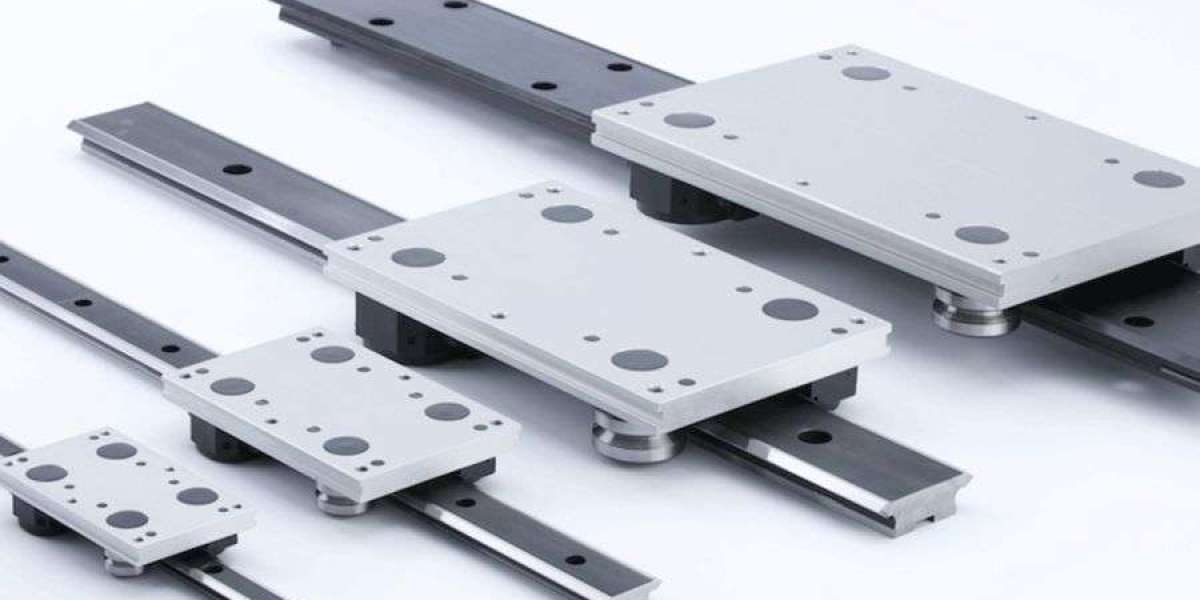This article provides a comprehensive comparison of linear rail bearings with alternative linear motion systems, highlighting their differences in design, performance, and applications. We'll also discuss how to select the optimal solution for your project and showcase how linear rail bearings continue to evolve to meet the demands of modern engineering.
Linear Rail Bearings: An Overview
Linear rail bearings are precision-engineered systems that consist of a rail (guide rail) and a carriage (slider) with rolling elements (balls or rollers) that reduce friction and enable smooth, linear motion. They are designed to support heavy loads, maintain high rigidity, and achieve micron-level accuracy, making them ideal for applications requiring precision and reliability.
Key Advantages of Linear Rail Bearings
- •
High Load Capacity: Capable of supporting heavy loads (up to 200,000 N per rail) with minimal deflection.
- •
Precision: Achieves micron-level accuracy (±0.001 mm) with preloaded designs.
- •
Rigidity: Resists deformation under heavy forces, ensuring stability during high-speed or high-force operations.
- •
Versatility: Available in various sizes and configurations to suit different applications.
Comparison with Alternative Linear Motion Systems
1. Linear Rail Bearings vs. Linear Slide Bearings
Linear slide bearings, such as plain bearings or ball-bearing slides, are simpler systems that use sliding or rolling elements to facilitate motion along a shaft or rail.
Feature | Linear Rail Bearings | Linear Slide Bearings |
|---|---|---|
Load Capacity | High (up to 200,000 N) | Medium (up to 5,000 N) |
Precision | High (±0.001 mm) | Standard (±0.01–0.1 mm) |
Rigidity | High (resists deflection) | Low (prone to bending) |
Cost | Moderate–High | Low |
Best For | CNC machines, heavy automation | DIY projects, light automation |
When to Choose Linear Rail Bearings: For applications requiring high precision, heavy loads, or resistance to vibration.
When to Choose Slide Bearings: For cost-sensitive, low-load tasks like 3D printers or small conveyors.
2. Linear Rail Bearings vs. Ball Screws
Ball screws convert rotational motion into linear motion using recirculating balls between a screw and nut.
Feature | Linear Rail Bearings | Ball Screws |
|---|---|---|
Motion Type | Direct linear motion | Linear motion via screw rotation |
Speed | High (up to 5 m/s) | Moderate (limited by screw length) |
Precision | High (with preloaded guides) | Very High (with preloaded nuts) |
Load Capacity | High (distributed across rail) | Medium (concentrated on screw) |
Best For | High-speed automation, heavy loads | Precision positioning, thrust tasks |
When to Choose Linear Rail Bearings: For applications prioritizing speed, rigidity, and multi-axis motion.
When to Choose Ball Screws: For tasks requiring high thrust force and precise linear displacement.
3. Linear Rail Bearings vs. Belt-Driven Systems
Belt-driven systems use a motorized pulley and belt to move a carriage along a rail.
Feature | Linear Rail Bearings | Belt-Driven Systems |
|---|---|---|
Load Capacity | High (up to 200,000 N) | Low–Medium (up to 1,000 N) |
Speed | Moderate (up to 2 m/s) | High (up to 10 m/s) |
Rigidity | High (resists vibration) | Low (prone to deflection) |
Maintenance | Low (sealed carriages) | Moderate (belt wear) |
Best For | Heavy automation, precision tasks | High-speed, low-load applications |
When to Choose Linear Rail Bearings: For stable, high-load motion where vibration control is critical.
When to Choose Belt Systems: For lightweight, high-speed tasks like packaging or material handling.
Selection Criteria for Linear Rail Bearings
- 1.
Load and Force Requirements: Calculate dynamic and static loads, including moment loads.
- 2.
Precision and Repeatability: Determine the required accuracy (e.g., ±0.001 mm for CNC applications).
- 3.
Speed and Acceleration: Ensure the bearing can handle the required speed and acceleration.
- 4.
Environmental Conditions: Consider corrosion resistance, dust protection, and temperature tolerance.
- 5.
Maintenance and Lifespan: Opt for sealed designs and long-lasting lubrication.
Conclusion
Linear rail bearings are a cornerstone of modern linear motion systems, offering a combination of precision, load capacity, and durability that is unmatched by alternative systems. Whether you're building a CNC machine, a robotic system, or a precision instrument, linear rail bearings provide the performance and reliability needed to succeed. By understanding their advantages and comparing them with other technologies, engineers can make informed decisions to optimize their designs. For high-quality linear rail bearing solutions, explore the offerings from leading manufacturers who combine cutting-edge engineering with durable materials.








